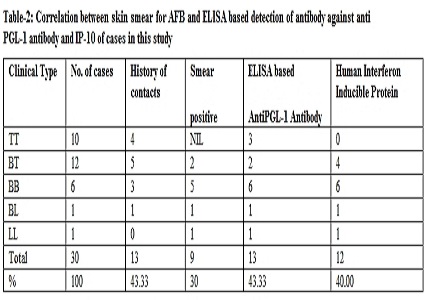Evaluation of diagnostic role of IP-10 (Interferon Gamma Inducible Protein) and anti PGL-1 antibody in pediatric leprosy
Abstract
Background: Leprosy is among the world’s oldest and most dreaded diseases and it has been synonymous with stigma and discrimination due to the hideous deformities it produced, mystery around its aetiology and transmission and lack of any effective remedy till recently. Leprosy is characterized by a long and variable incubation period and a chronic clinical course. Diagnosis of leprosy is essentially based on clinical features. Although the majority of cases can be diagnosed clinically yet alternative methods for diagnosis are required especially for early cases. The present study is aimed to assess the diagnostic value of anti PGL-1 antibody and Interferon Gamma Inducible Protein (IP-10) and to compare these techniques with skin smear.
Materials and Methods: A prospective study was done on 30 patients below 16 years of age between March 2014 to March 2015.
Results: In this study 13 / 30 (43.33%) cases were positive by Anti PGL-1 antibody based ELISA and 12/30 (40%) by IP-10 based ELISA against 9/ 30 (30.00%) cases by skin smears for AFB. Hence Anti PGL-1 and IP-10 based ELISA has more diagnostic value than slit skin smear for AFB in confirmation of leprosy cases.
Conclusion: This study supports that Anti PGL-1 antibody and Interferon Gamma induced protein (IP-10) enhance the diagnostic yield of leprosy when compared to routine skin smears stained by Z.N staining. They are important diagnostic tools for definitive diagnosis in early cases of leprosy.
Downloads
References
2. BrowNE, S. G. Differential diagnosis. In: Leprosy in 'Theory and Practice. 2nd ed. Cochrane, R. G. and Davey, T. F., eds. Bristol, England: John Wright and Sons. Ltd.. 1964, pp. 280-298.
3. Dharmendra. History of spread and decline of Leprosy .In: Leprosy vol 1 , Dharmendra , 1978; Kothari Medical Publishing House , Mumbai : 7-21. [PubMed]
4. Rastogi N, Rastogi RC. Leprosy in ancient India. Int J Lepr Other Mycobact Dis. 1984 Dec;52(4):541-3. [PubMed]
5. Hansen G H A. On the etiology of Leprosy . chirurigical Reviews,1875;55 : 459-489.
6. R. Dayal. IAP Text Book of Pediatrics , 4 th edition ,; PP387 -392.
7. WHO Weekly epidemiological record , 4 September 2015, No. 36, 2015, 90, 461–476.
8. Ganapati R, Parrikh A C, Sane A B et al Prevalence of Leprosy among childrens in greater Bombay. Paed Clin India, 1971. 6:13- 17. [PubMed]
9. Dayal R, Agarwal M, Natrajan M, Katoch VM, Katoch K, Singh K, Chauhan DS. PCR and in-situ hybridization for diagnosis of leprosy. Indian J Pediatr. 2007 Jul;74(7):645-8. [PubMed]
10. Nigam P, Verma B L, srivastava R N et al Clinico epidemiological study in a rural population of Bundelkhand .Lepr India , 1997, 48:349-358.
11. Dave DS, Agrawal SK. Prevalence of leprosy in children of leprosy parents. Indian J Lepr. 1984 Jul-Sep;56(3):615-21. [PubMed]
12. Bührer-Sékula S, Smits HL, Gussenhoven GC, van Leeuwen J, Amador S, Fujiwara T, Klatser PR, Oskam L. Simple and fast lateral flow test for classification of leprosy patients and identification of contacts with high risk of developing leprosy. J Clin Microbiol. 2003 May;41(5):1991-5. [PubMed]
13. Cellona RV, Walsh GP, Fajardo T T Jr, Abalos RM, la Cruz EC, Guido-Villahermosa L, Felicio-Balagon MV, Steenbergen GJ. Cross-sectional assessment of ELISA reactivity in leprosy patients, contacts, and normal population using the semisynthetic antigen natural disaccharide octyl bovine serum albumin (ND-O-BSA) in Cebu, The Philippines. International Journal of Leprosy and Other Mycrobacteriology Diseases 61: 192-198, 1993.
14. Cho SN, Yanagihara DL, Hunter SW, Gelber RH, Brennan PJ. Serological specificity of phenolic glycolipid I from Mycobacterium leprae and use in serodiagnosis of leprosy. Infect Immun. 1983 Sep;41(3):1077-83.
15. Barreto JG , Guimaraes Lde S , Leao MR , Ferreira DV , Lima RA, Salgado CG . Anti – PGL-1 seroepidemiology in leprosy cases : household contacts and school children from a hyperendemic municipality of the Brazilian Amazon.Lepr Rev.2011 Dec; 82(4) : 358-70.
16. Douglas JT, Cellona RV, Fajardo TT Jr, Abalos RM, Balagon MV, Klatser PR. Prospective study of serological conversion as a risk factor for development of leprosy among household contacts.Clinical and Diagnostic Laboratory Immunology 11: 897-900, 2004.
17. Elizabeth Whittaker, Andrea Gordon and Beate Kampmann .Is IP-10 a better biomarker for active and latent Tuberculosis in children than IFN gamma ? PLoS ONE .2008 ; 3(12): e 3901.
18. Meeker , H. C., Schuller –Levis , G.. Fusco, F.,Giardina –Becket , M. A.. Sersen , E. and Levis,W. R. Sequential monitoring of leprosy patients with serum antibody levels to phenolic glycolipid- I, a synthetic analog of phenolic glycolipid-I and mycobacterial lipoarabinomannan. Int. J. Lepr. 58(1990) 503-511. [PubMed]
19. Scollard DM, Chaduvula MV, Martinez A, Fowlkes N, Nath I, Stryjewska BM, Kearney MT, Williams DL. Increased CXC ligand 10 levels and gene expression in type 1 leprosy reactions. Clin Vaccine Immunol. 2011 Jun;18(6):947-53. doi: 10.1128/CVI.00042-11. Epub 2011 Apr 20. [PubMed]
20. Geluk, A., J. J. van der Ploeg-van Schip, K. E. van Meijgaarden, S. Commandeur, J. W. Drijfhout, W. E.Benckhuijsen, K. L. Franken, B. Naafs, and T. H. Ottenhoff. 2010. Enhancing sensitivity of detection of immuneresponses to Mycobacterium leprae peptides in whole-blood assays. Clin. Vaccine Immunol. 17: 993– 1004.

Copyright (c) 2017 Author (s). Published by Siddharth Health Research and Social Welfare Society

This work is licensed under a Creative Commons Attribution 4.0 International License.


 OAI - Open Archives Initiative
OAI - Open Archives Initiative


